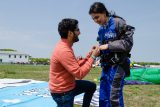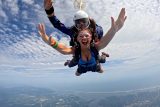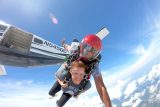The Skydiving Pose Every Beginner Needs To Know: The Arch
General
Posted by: Long Island Skydiving Center
4 years ago
Over time people have figured out how to skydive in a lot of different positions. With enough practice, it is basically possible to fly in any orientation you can think of by assembling the various parts of your body into the correct poses. This is achieved by manipulating what is called the ‘relative wind’ – the effect of wind speed generated by falling through the air at terminal velocity (around 120mph). The relative wind is a force that can be manipulated with all the surfaces of your body to create the desired effects – static, stable positions and intentional movement. The skill you need takes time to master, and everybody starts at the beginning – with the arch position.

Stability
The arch pose is probably what you are thinking of when you picture skydiving – people falling with their bellies pointed towards the ground, their arms and legs out wide and with their heads up looking forwards. This is because the belly flying or arch position is the easiest way to find stability when you are new to skydiving, and stability is key. If you are a little wobbly in the air when you are trying to move around, you are just going to learn wobbly moves. Finding neutral with your skydiving arch position is the foundation on which everything else gets built, so whether your first jump is a tandem skydive attached to an instructor, or an AFF (accelerated freefall) training jump – a nice strong arch position is what you need.

Science
If one part of your body is trying to fall quickly, and another part slowly, the quick part will point towards the ground. This is what happens while falling through the relative wind when you assume an arch pose – your hips are the lowest part of your position, while your arms and legs out wide and up high. Your limbs are creating drag and trying to go slower, which has the effect of generating stability and always keeping your hips pointed downwards. The best way to think about this is the same way a shuttlecock works when playing badminton. The ball part is your hips, the feathers part your arms and legs. When the shuttlecock is hit, it will always quickly end up traveling through the air in the direction of the ball part – because the feathers are creating drag and therefore stability.
Practice
We do the skydiving arch first because it is easy to do, and you can indeed practice on the ground before you go for your skydive. The best way to give it a try is by lying flat on the ground, then in one smooth motion arch backwards from the hips – picking up your arms and legs at the four corners and holding your chin up to look forwards. You only need to do this for a few seconds, as it becomes hard work quite quickly. Don’t worry though, it only requires this physical effort while on the ground. Up in the sky during freefall you are supported all over by the relative wind, which makes it such a comfortable position to hold for the duration of a skydive that you won’t even notice at all.

…
Due to the level of control you can achieve by manipulating the relative wind, when you go skydiving you are not falling – but very much flying. The things that can be done up in the air are mind-blowing, and it all begins with that first arch position. A good skydiving arch pose will find you instantly comfortable in freefall, able to relax and soak up the awesome sensation of what skydiving is all about – having the most fun ever.
Categories:
You May Be Interested In:

Is A Skydiving Proposal A Good Idea?
6 months ago by Long Island Skydiving Center

Skydiving For Couples: Fun Date Activity In NYC
6 months ago by Long Island Skydiving Center

Where Can I Go Skydiving in New York?
8 months ago by Long Island Skydiving Center

What Is A Skydiving Landing Like?
8 months ago by Long Island Skydiving Center